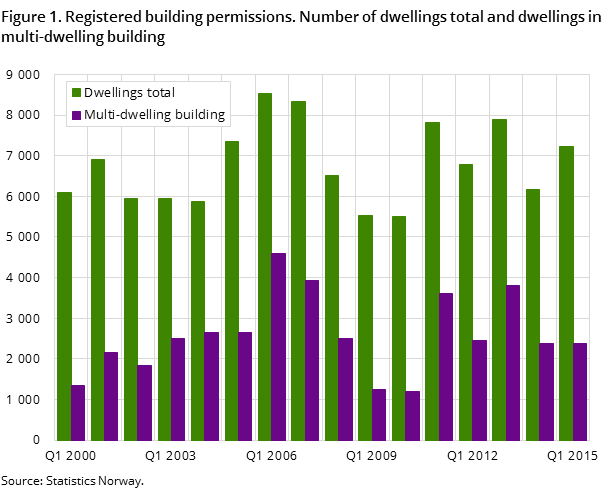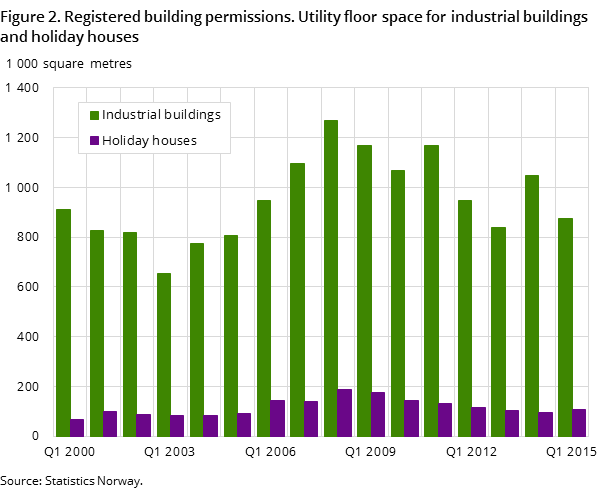Content
Published:
This is an archived release.
More student homes
In the first quarter of 2015, building start permits were given on 7 200 dwellings, with a total of about 909 000 square metres of utility floor space. New dwellings increased by almost 18 per cent compared with the first quarter of 2014. Student dormitories made up a large share of the increase.
| 1st quarter 2014 | 1st quarter 2015 | Changes in per cent | |
|---|---|---|---|
| Number of dwellings | |||
| Registered building permissions | 6 160 | 7 238 | 17.5 |
| Registered completed | 6 356 | 6 519 | 2.6 |
| Utility floor space other than in dwellings, 1000 m2 | |||
| Registered building permissions | 1 312.1 | 1 174.9 | -10.5 |
| Registered completed | 1 033.0 | 1 292.2 | 25.1 |


Building start permits for residences for communities and houses with 2 dwellings had the greatest increase. In first quarter of 2015, the number of permits for residences for communities increased by 430 per cent compared with first quarter last year. Similarly, houses with 2 dwellings had an increase of 44 per cent. Student dormitories in Trondheim and Lillehammer had a growth of 850 single rooms.
Most building start permits in Sør-Trøndelag
The county of Sør-Trøndelag had the most dwelling start permits, with 1 022, followed by Rogaland, Akershus and Oslo counties with 887, 870 and 834 dwelling start permits respectively.
Decrease in industrial sector
In the first quarter of 2015, building start permits were given on about 876 000 square metres of utility floor space within the industrial sector. This is a decrease of around 16 per cent compared with the same quarter in 2014. The level of building activity is especially low within buildings for offices and business and buildings for transport and communication.
Demolition of buildings
As of the first quarter of 2015, figures on demolished dwellings and buildings are available. Quarterly and annual figures for 2009 and onwards are published in Statbank.
In the first quarter of 2015, a total of 959 dwellings were demolished, of which 567 were detached houses. For buildings other than residential buildings, 1 646 buildings in the industrial sector were pulled down, and 2 875 holiday homes and private garages were demolished.
Registered building permissionsOpen and readClose
Figures for buildings in the building statistics rely on dates for when permits are registered by the municipality in the data register (Matrikkelen). A building permit does not always mean that construction will be started at once. Especially in low conjunctures it might be that construction projects are not realised, or may be postponed after a building permit has been granted. When the building activity trend turns from a low to a high level, and vice versa, this could affect the interpretation of the statistics.
More details about comparability, quality and other information are available in About the statistics .
Rebuilding of existing building stockOpen and readClose
Building statistics do not cover dwellings due to rebuilding of existing building stock (i.e. new dwellings due to reconstruction of utility floor space from industry to dwellings).
When an old building is being demolished to the foundation wall, it is regarded as a new building. When the building framework is not demolished, it counts as rebuilding.
For more information, see About the statistics .
Contact
-
Jens Mathiesen
E-mail: jens.mathiesen@ssb.no
tel.: (+47) 40 81 13 98
-
Magnus Espeland
E-mail: magnus.espeland@ssb.no
tel.: (+47) 45 27 40 08
